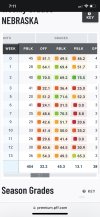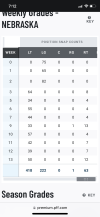LEARN ABOUT PFF PLAYER GRADES
PFF grades have become synonymous with player performance in both the NFL and college football over the last 10-plus years, but what goes into creating those player grades?
WHAT WE DO
The PFF grading system evaluates every player on every play during a football game. We believe that #EveryPlayCounts and that attention to detail provides insights and data that cannot be found anywhere else. The grading system was founded on the principle of grading “production” rather than traits or measurables, but perhaps a better way to describe it is a player’s “contribution to production” on a given play.
Did the quarterback make a great throw, but it was dropped? The quarterback contributed to positive production and will receive a positive grade for that effort, even though the receiver let him down, earning a negative grade along the way.
The benefits of this style of grading are numerous. Taking every play into consideration allows for a larger sample size of data to tell the proper story rather than just a highlight reel of plays that we tend to remember, for better or worse. We also work to eliminate bias by not caring about the level of player who is being graded, so whether it’s the best tackle in the league missing a block or one of the worst, the same grade is given. Preconceived level of ability has no impact on the grading system. This style has worked well in unlocking undervalued gems through the years, while also not being swayed by player hype if it is undeserved.
THE GRADING SCALE
Each player is given a grade of -2 to +2 in 0.5 increments on a given play with 0 generally being the average or “expected” grade. There are a few exceptions as each position group has different rules, but those are the basics. The zero grade is important as most plays feature many players doing their job at a reasonable, or expected, level, so not every player on every play needs to earn a positive or a negative.
At one end of the scale you have a catastrophic game-ending interception or pick-six from a quarterback, and at the other a perfect deep bomb into a tight window in a critical game situation.
Each position has its own grading rubric so our analysts know how to put a grade on the various expectations for a quarterback on a 10-yard pass beyond the sticks or what the range of grades might look like for a frontside offensive tackle down blocking on a “power” play.
There is then an adjustment made to the “raw” grades to adjust for what the player is “expected” to earn given his situation on the field. For instance, a player’s grade may be adjusted down slightly if he plays in a situation that is historically more favorable while a player in more unfavorable circumstances may get an adjustment the other way. We collect over 200 fields of data on each play, and that data helps to determine what the baseline, or expectation, is for each player on every play.
Each grade goes into a specific “facet” of play in order to properly assess each player’s skillset. The facets include passing, rushing, receiving, pass blocking, run blocking, pass-rushing, run defense and coverage. Special teamers also have their own facets of kicking, punting, returning and general special teams play. Facets are important in order to have a clear view of where a player’s strengths and weaknesses lie.
A collection of grading examples across all facets of play is included on this page.
WHO IS DOING THE GRADING?
PFF employs over 600 full or part-time analysts, but less than 10% of analysts are trained to the level that they can grade plays. Only the top two to three percent of analysts are on the team of “senior analysts” in charge of finalizing each grade after review. Our graders have been training for months, and sometimes years, in order to learn, understand and show mastery of our process that includes our 300-page training manual and video playbook. We have analysts from all walks of life, including former players, coaches and scouts. We don’t care if you played.
Each grade is reviewed at least once, and usually multiple times, using every camera angle available, including All-22 coaches’ tape.
YOU DON’T KNOW THE PLAY CALL?
We are certainly not in the huddle, but we are grading what a player attempts to do on a given play. While football is extremely nuanced regarding the preparation and adjustments that go into each play call, once the ball is snapped, most players are clear in what they’re trying to accomplish on each play, and we evaluate accordingly. Of course, there are always some gray areas in football. Plays in which there is a clear question mark regarding assignment, we can defer to a “0” grade and not guess as to which player is right or wrong. These plays are few and far between and since we are grading every snap, missing out on a handful throughout the year should not affect player evaluations. Examples of potential gray areas include coverage busts, quarterback/wide receiver miscommunications and missed blocking assignments.
CONVERTING THE GRADES
The plus-minus grades are then converted to a 0-100 scale at the game and season level. This makes it easier to compare players across positions relative to their peers, though it doesn’t account for positional value, i.e. which positions are most valuable when trying to predict wins.
Season-level grades aren’t simply an average of every game-grade a player compiles over a season, as the season grade credits the entire body of work. An 80.0 game grade is not close to one of the best games of all-time, but 16 games of 80.0 grades will equal an outstanding season of consistency and likely one of the better seasons in a given year. A simpler example is a three-touchdown game from a quarterback. We’ve seen many three-touchdown games but doing so in all 16 games would be one of the best seasons of all-time.
It is entirely possible that a player will have a season grade higher than any individual single-game grade he achieved because playing well for an extended period of time is harder to do than for a short period.
PLAYER RANKINGS
The grades allow for easy player comparisons, whether using an overall grade or a facet grade. While we believe the grade is an excellent baseline for how well a player performed his given role, we also believe the using the entire context is crucial when evaluating players. Perhaps a slot receiver had to play more than expected on the outside or a nose tackle was forced to play more three-technique than his coaching staff initially desired. Both players are being evaluated based on what they did, and that context is important when using the grades. PFF+ allows users to sort by player grades, but they can also see the simple and advanced stats that tell the story for each player.
Want to see who was the best pass protecting offensive tackle? The best run-stopping linebacker? It’s all in
Premium Stats 2.0 as part of PFF+.
Premium Stats allows you to not only rank players by position but also filter by teams, to compare the grades of just one team’s cornerbacks, for example. We also combine defensive fronts and group players as either edge defenders, or interior defenders, to save confusion between 4-3 and 3-4 defensive fronts that in today’s NFL are often in the same alignment by defensive technique, just from either a two- or three-point stance.
It’s important to understand that PFF is not grading talent in these numbers, rather strictly performance on the field. Talented players can have bad games, runs, or even seasons, and often players without nearly as much talent can put together impressive play on the field. We are not necessarily telling you who the best players are. Our rankings are more of a performance evaluation and a reflection of how efficiently a player made plays in the time he was on the field.
GRADES VS. STATS
We aren’t grading players based on the yardage they rack up or the stats they collect. Statistics can be indicative of performance but don’t tell the whole story and can often lie badly. Quarterbacks can throw the ball straight to defenders but if the ball is dropped, you won't see it on the stat sheet. Conversely, they can dump the ball off on a sequence of screen passes and end up with a gaudy looking stat line if those skill position players do enough work after the catch.
PFF grades the play, not its result, so the quarterback that throws the ball to defenders will be downgraded whether the defender catches the ball to notch the interception on the stat sheet or not. No amount of broken tackles and yards after the catch from a bubble screen will earn a quarterback a better grade, even though his passing stats may be getting padded.
The same is true for most positions. Statistics can be misleading. A tackle whose quarterback gets the ball out of his hands quicker than anybody else may not give up many sacks, but he can still be beaten often and earn a poor grade. Receivers that are targeted relentlessly could post big-time numbers but may offer little more than the product of a volume-based aerial attack.
Here’s a great example from the 2016 season as to why grades and stats may not match up:
In 2016, Atlanta Falcons edge rusher Vic Beasley led the NFL in sacks in a breakout season for the NFC Champions, but he was only the 31st-ranked edge rusher in terms of PFF pass-rushing grade. Here are some of the things to note about how Beasley rated in our system:
Not all sacks are created equal
Beasley sacked the quarterback 16 times, but eight of those sixteen were either unblocked or clean-up sacks that owed more to somebody else flushing the quarterback towards where Beasley was than they did to him beating a blocker to make the play. PFF grading takes into account the quality of the play made to get the sack, and excellent plays to defeat blocks will be graded higher than sacks where the quarterback just happened to be flushed past a player as he was being blocked only to get taken down.
Pressures matter
All pass-rushers are trying to sack the quarterback, but even the best will only do so on around three percent of their snaps on the field. Hits and hurries combine with sacks to form a much more robust picture of total pressure generated.
Pressure that does not result in a sack is important too, as just pressuring the quarterback sees an average drop in passer rating of 32.0 points from 94.4 to 61.8 over the past 10 years. That’s the equivalent of turning Ben Roethlisberger into Blaine Gabbert just by hurrying him in the pocket.
Beasley led the league in sacks, but he was just 18th even among edge defenders when it comes to total pressures. Compare that to a player like Oakland’s Khalil Mack who led the league with 96 combined sacks, hits and hurries, and Beasley has a significant deficit in total pressure.
When we used our analytics to run numbers to find out just how valuable pressure was compared to sacks, our Expected Points Added data showed that a sack is worth around 2.1 pressures of any other kind. So, a player like Mack would only need to have had an extra 11 hits or hurries to have added more value as a pass-rusher than Beasley despite having five fewer sacks over the season. Mack, in reality, had 40 more pressures, and so had a significantly higher PFF grade than Beasley.
Run defense matters
Mack’s overall grade of 95.2 was also far higher than Beasley’s 74.2 because Khalil Mack was one of the best run defenders in the game, capable of shedding blocks and knifing into the backfield to blow up plays. Beasley wasn’t nearly as accomplished in this area, an area that can get lost in all the talk of sacks but is counted in the PFF grading.
HOW DO WE USE IT?
The PFF grading dates back to 2006 for NFL and 2014 for college football, and we’ve gleaned many unique insights along the way. As mentioned, context is key as each position group comes with its own challenges when trying to isolate each player from a grading perspective. We understand that PFF grade is not perfect, but it’s also a unique look at a player’s production, and when paired with PFF’s advanced data, it’s one of the most powerful tools in the game. PFF grading is both descriptive and predictive, and in many cases, we’ve debunked myths about traditional stats, showing that the production grade is a better indicator of what happened on the field and what will happen going forward.








